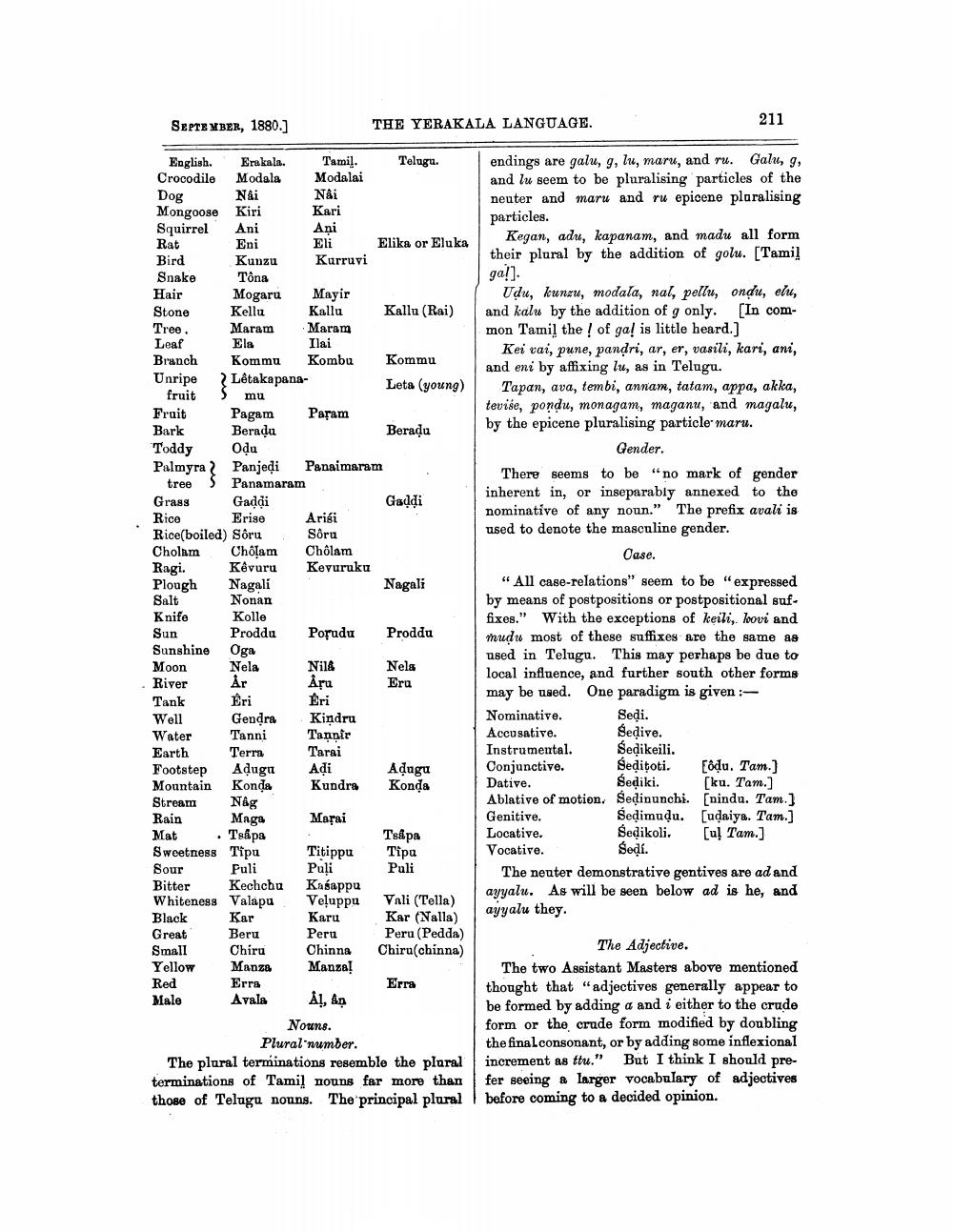________________
SEPTEMBER, 1880.]
THE YERAKALA LANGUAGE.
211
Dog
N&i
English. Erakala. Tamil.
Telugu. Crocodile Modala Modalai
Nai Mongoose Kiri Kari Squirrel Ani Ani Rat Eni
Eli
Elika or Eluka Bird Kunzu Kurruvi Snake
Tôna Hair Mogaru Mayir Stone
Kellu Kallu Kallu (Rai) Tree.
Maram Maram Leaf Ela
Ilai Branch Kommu Kombu Kommu Unripe Lêtakapana
Leta (young) fruit ) mu Fruit Pagam Param Bark Beradu
Beradu Toddy Odu Palmyra Panjeţi Panaimaram
tree ) Panamaram Grass Gadài
Gaddi Rice Erise Arisi Rice(boiled) Sôru Sôru Cholam Cholam Chôlam Ragi. Kêvuru Kevuruku Plough Nagali
Nagali Salt Nonan Knife Kolle Sun Proddu Posudu Proddu Sunshine Moon
Nela Nil& Nela River År Åru Eru Tank Eri Eri Well Gendra Kindru Water
Tanni Tannir Earth Terra Tarai Footstep Adugu Adi
Adugu Mountain Konda Kundra Konda Stream Rain Mags
Marai Mat Tsápa
Ts&pa Sweetness Tipu
Titippu Sour Puli Puli Puli Bitter Kechcha Kasappu Whiteness Valapu Veluppu Vali (Tella) Black Kar Karu Kar (Nalla) Great Beru Peru Peru (Pedda) Small Chiru Chinna Chiru(chinna) Yellow Manza
Manza! Red Erra
Erra Male Avala Å!, An
Nouns.
Plural number. The plural terminations resemble the plural terminations of Tamil nouns far more than those of Telugu nouns. The principal plural
endings are galu, g, lu, maru, and ru. Galu, 9, and lu seem to be pluralising particles of the neuter and maru and ru epicene pluralising particles.
Kegan, adu, kapanam, and madu all form their plural by the addition of golu. [Tamil ga!).
Udu, kunzu, modala, nal, pellu, ondu, elu, and kalu by the addition of g only. [In common Tamil the ! of ga! is little heard.]
Kei vai, pune, pandri, ar, er, vasili, kari, ani, and eni by affixing lu, as in Telugu.
Tapan, ava, tembi, annam, tatam, appa, akka, tevise, pondu, monagam, maganu, and magalu, by the epicene pluralising particle maru.
Gender. There seems to be "no mark of gender inherent in, or inseparably annexed to the nominative of any noun." The prefix avali is used to denote the masculine gender.
Oase. “All case-relations" seem to be "expressed by means of postpositions or postpositional suffixes." With the exceptions of keili, Loovi and mudu most of these suffixes are the same as used in Telugu. This may perhaps be due to local influence, and further south other forms may be used. One paradigm is given :Nominative. Sedi. Accusative.
Sedive. Instrumental. Sedikeili. Conjunctive. Seditoti. Eodu. Tam.] Dative.
Sediki. [ku. Tam.] Ablative of motion. Sedinunchi. [nindu. Tam.) Genitive.
Sedimudu. [udaiya. Tam.] Locative.
Sedikoli. [u! Tam.] Vocative.
Sedí. The neuter demonstrative gentives are ad and ayyalu. As will be seen below ad is he, and ayyalu they.
Oga
Någ
Тіра
The Adjective. The two Assistant Masters above mentioned thought that "adjectives generally appear to be formed by adding a and i either to the crude form or the crude form modified by doubling the final consonant, or by adding some inflexional increment as ttu." But I think I should prefer seeing a larger vocabulary of adjectives before coming to a decided opinion.




